In these lessons, students will learn how to respond to the play not just as a piece of writing, but as a piece of drama. Tasks include: responding to design elements such as set design and music; creating posters, set designs and other materials to help imagine and bring to life their own productions.
In order to benefit fully from these lesson plans, we recommend you use them in the following order:
- Text in Performance
- Language
- Characters
- Themes
- Contexts
If students are new to the play, we suggest you start with these introductory KS3 Lesson Plans. If you would like to teach the play in greater detail, use the advanced KS4/5 Lesson Plans.
Key Questions for Students:
Can I explain what a theatre director does?
Can I show understanding of some factors to bear in mind when casting a play?
Key words: actor, casting, director, rehearsal, production
Prologue: Opening Discussion
Using the Directing Shakespeare PowerPoint (in the Downloads section of this page), students are shown the following series of images from rehearsal rooms where the director is in the shot.
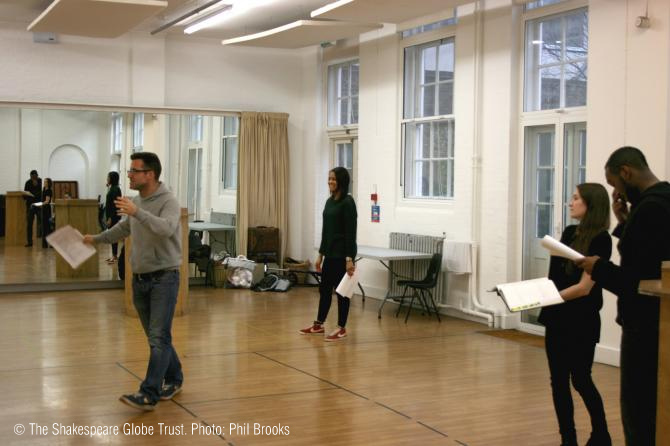
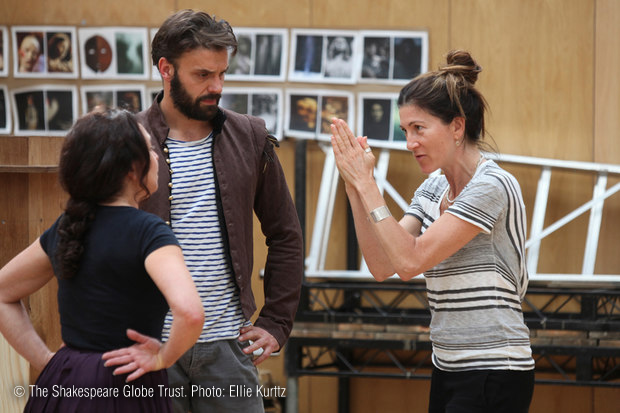
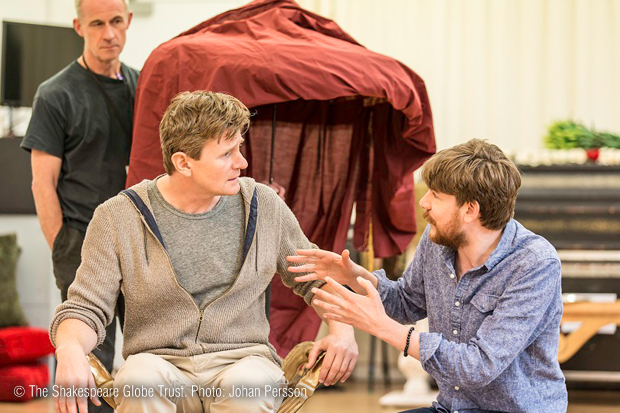
Ask students to discuss for each picture:
- Who is the director?
- Why do you think this?
- What clues do their body language and facial expressions give us about their role?
Now students could be asked to think more broadly about what the job of the director involves. The Globe blog (blog.shakespearesglobe.com) and Playing Shakespeare with Deutsche Bank website (playingshakespeare.org) feature images of directors working with actors in rehearsal which might be used at this point, as well as interviews with directors. Ideas could be captured on one big brainstorm or list and can also then be recorded by students in their Student Booklets.
Enter the Players: Group Tasks
1) Becoming a director
Students could consult two sources in more depth to investigate the role of the director.
- Listen to an excerpt from the Globe Adopt a Director podcast at shakespearesglobe.com/discovery-space/adopt-an-actor/archive/tempest-directed-by-jeremy-herrin. Play this from 1 minute 10 seconds to 1 minute 53 seconds only. Students add key points to their brainstorms.
- Read Rex Gibson’s ‘Guidelines for student directors’ (pp. 183-84) – featured in the Student Booklet – in pairs. Students could summarise each of the nine points Gibson makes in a single word and feedback some examples, before adding their new ideas to their brainstorms.
You could ask a few students to give their ‘top three’ words from their brainstorms that encapsulate the director’s role.
2) Headshots
This activity moves on to the job of casting the play and can be found in the Student Booklet. Give each group one of the main characters from Macbeth and ask them to consider the attributes and qualities they would be looking for in an actor who plays that part. Students could select two actors they would like to invite to audition for the part and rank them. Some actors may get invited to audition for more than one part!
3) My Dream Cast
Instruct students to turn to the Dramatis Personae page at the start of the Student Booklet. You could mention some of the famous actors who have played the roles of Macbeth and Lady Macbeth over the years. Ask students to cast the play using any actors they choose from the worlds of TV, film and theatre. Students should give feedback on their casting decisions ensuring that they justify their choices.
Exeunt: Closing Questions for Students
How much does a director ‘direct’ what goes on in a production of a Shakespeare play?
What else does the director do and what skills do directors need?
To what extent and in what ways is a play a collaborative effort?
Suggested plenary activity…
Students write on sticky notes some ideas in the form of ‘director’s notes’ for the actors playing Macbeth and Lady Macbeth. They could be single words, longer comments or key quotations. Collect these ‘director’s notes’ for use in future lessons.
Asides: Further Resources
- Students can visit the Adopt An Actor archive, which features blog posts and podcasts by actors in previous Globe productions of Macbeth: shakespearesglobe.com/adoptanactor
- If students are completely unfamiliar with the play at this stage, they can be supported in a variety of ways including: scene-by-scene plot synopsis, quiz, character profile pages, a chance to read or watch a short retelling of the plot. These can be found on the Playing Shakespeare with Deutsche Bank website for Macbeth: 2011.playingshakespeare.org
Epilogue: Teacher's Note
Students could return to these points about the role of the director throughout their studies, particularly when stepping into the role of director in their groupwork and ensemble performances, etc.
Key Questions for Students:
Can I investigate how Macbeth has been interpreted by different directors?
How can a moodboard help a director develop and share his or her original ideas about the play?
What ideas would I bring to staging Macbeth?
Key words: interpretation, moodboard, music, poster, setting, vision
Prologue: Opening Discussion
Students could be shown the following quotation by Globe director Bill Buckhurst about staging Macbeth:
'It’s quite hard to read it that first time when you’ve been asked to direct it without taking on board all those images you’ve got of the productions you’ve seen. But you try and do that, and certainly I tried my best to sort of get them out of my brain the first time I read it through.'
With this in mind, ask students to close their eyes as you talk them through a very generalised plot of Macbeth. This shouldn't refer to people, places or times, perhaps not even to gender, e.g. ‘This is a story about a strong and courageous person who was very loyal to their leader. The kind leader wanted to reward such a loyal servant and did so. One day a strange event took place while this person was out walking with a good friend…’ Suggest to students that the action being described could be happening today in their neighbourhood or somewhere far away, perhaps in another time. Encourage students to think freely and creatively and to develop in their mind’s eye a setting that they think might work if they were staging their own production of Macbeth.
Enter the Players: Group Tasks
1) ‘Give me some music’
Play to students various pieces of music from productions of Macbeth; these can be from stage or screen versions, for example, the 2015 production starring Michael Fassbender. Ask students to write down what the music suggests to them. Draw out from the feedback that music can suggest a particular mood, a particular setting, or a particular type of activity that is going on.
2) Macbeth gallery
Provide a gallery of Macbeth production posters and book covers which could be displayed around the classroom. Ask students to tour the images, making notes in the Student Booklet about what the images show. Students could first of all be asked to stand by their favourite one. They should then discuss in their groups:
- What do the images tell you or suggest to you about the play’s storyline? (especially if they are new to the play)
- What does each image emphasise in particular about the play? (alternative question if students have more prior knowledge)
- Which ideas would I like to borrow or be inspired by when thinking about the mood and setting of my own production?
3) Creative brief: moodboard
To prepare for this task, students could watch this video of marketing designer Adrian (2013.playingshakespeare.org/week-by-week/73.html). He talks about how a director’s vision for a play is interpreted by the design team who work on a production. Assign students the task of producing a moodboard for their own production of Macbeth. The brief for this task can be found in the Downloads section at the bottom of this page. Here are some Top Tips:
- Make it bold so that it immediately grabs the attention of the viewer.
- Be as creative as possible so that it is unique from any competition.
- Make sure that all the information can be read clearly so that no important details about the show are lost.
- Think about who the poster is aimed for and target it for that particular market.
- Consider the subject matter for your poster. You need to research and understand the topic before you begin designing.
Exeunt: Closing Questions for Students
What have I learned about different ways that directors have interpreted Macbeth and different settings they have chosen?
What ideas do I have about staging the play and how would I pitch them to a producer?
Suggested plenary activity:
Students should share their ideas about staging the play with a partner and listen to their ideas. They should then use their feedback to further develop and refine these ideas; this will assist them with the moodboard task. Ideas should be creative and perhaps daring, but also coherent.
Aside: Further Resource
- Pinterest or other similar websites could be useful to help students understand the idea of ‘pinning’ ideas to a ‘board’, with their own comments added.
Epilogue: Teacher's Note
A moodboard (perhaps accompanied by a spoken or written commentary) could be the basis for a mid-unit assessment.
Key Questions for Students:
Can I identify some of the different opportunities and challenges that set designers face in different styles of theatres?
Can I find out about what the stage looked like in Shakespeare’s time in theatres like the Globe?
Can I imagine how I would create a sense of time and place in my production?
Key words: lighting, set design, set designer, setting, special effects
Prologue: Opening Discussion
The Setting the Scene PowerPoint (in the Downloads section of this page) shows the following set designs from various productions of Macbeth. Ask students to reflect on the following images in the light of what they know about the Globe stage.
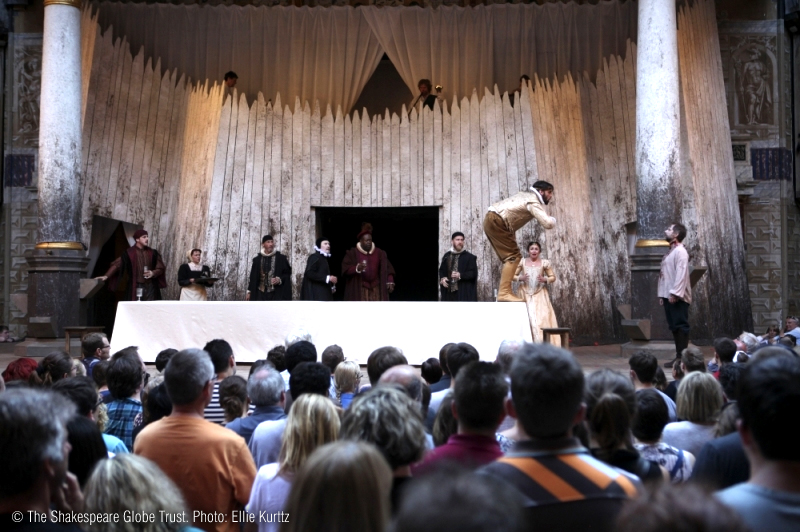
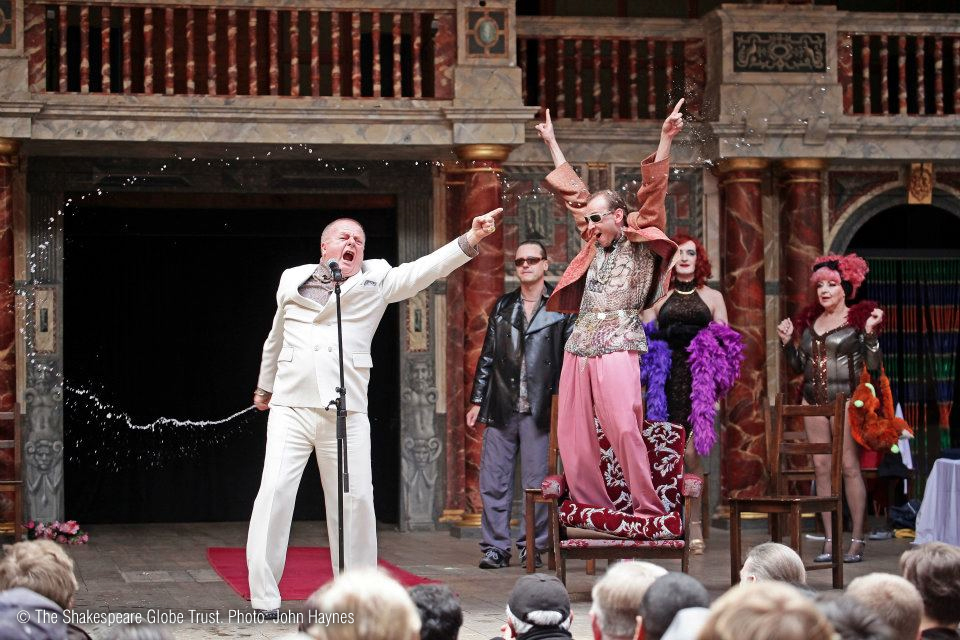
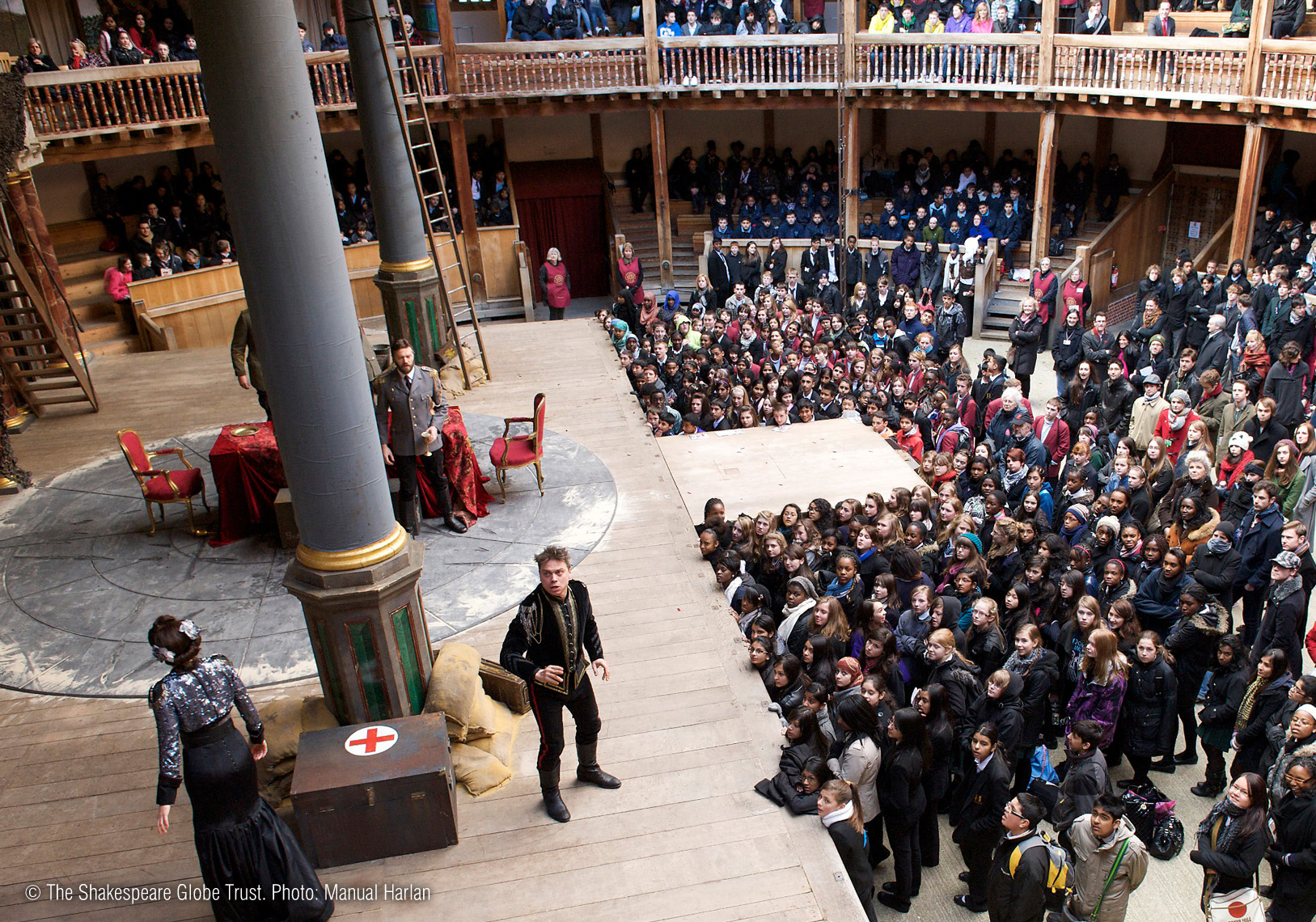

Questions to consider:
- What does a set designer at the Globe need to bear in mind? What is and isn’t possible?
- What are the challenges and opportunities of working with different layouts?
N.B. Comments might include the following, and this discussion will help you to ascertain students’ prior knowledge and could govern your choice of subsequent activities. The activities in ‘Enter the Players’ and the linked factsheets will support students’ learning in all of the following areas:
- set designs in Shakespeare’s times were not elaborate
- however, various special effects and the areas above and below the stage were used in imaginative ways
- benefits and limitations of apron stage v. proscenium arch
- the idea of hearing rather than watching a play
- how much the stage should change throughout the performance and how much will stay the same
- technical and financial implications of elaborate staging
- the importance of lighting/the fact that the Globe is open air and many performances take place in the daytime
- the clues about time and place provided within the language
- stage extensions can be added at the Globe
Enter the Players: Group Tasks
1) Staging a play at the Globe
In this video (2015.playingshakespeare.org/week-by-week/142), Globe director Bill Buckhurst speaks about the atmosphere at the Globe and the factors that contribute to this. Students could make notes in their Student Booklet in answer to the questions:
- How does Bill Buckhurst describe the general atmosphere at the Globe?
- What is it about the theatre space that creates this atmosphere?
The following quotation by Fiona Banks focuses more specifically on setting the scene and can be displayed to students on the ‘Words, Words, Words’ PowerPoint. This is available in the Downloads section at the bottom of this page and also in the Student Booklet.
'In the original Globe theatre, there would have been little in terms of elaborate set design and props, although stage effects were often used. The back of the stage was painted, as were the heavens and the pillars, but there was no particular set that changed with each play. Shakespeare uses language to set the scene for his audience and to ensure they have all the information they need about what is taking place on stage.'
Students could read this quotation and then re-read the last sentence, speculating about exactly what she means, i.e. ‘How does Shakespeare use language to set the scene?’ and ‘How does Shakespeare use language to provide the audience with all the information they need?’ Establishing these two questions and beginning to speculate about possible answers will lead effectively into the next activity.
2) Text detectives: setting the scene
Now students could read the opening lines of Act 1 Scene 6 (lines 1-10) or Act 3 Scene 3 (lines 4-18) in the Student Booklet and highlight:
- where and when Shakespeare is setting the scene
- what the dialogue tells us about characters’ actions and reactions or props that are important in the scene
Students should annotate the text with their findings. In the feedback, draw attention to how much Shakespeare communicates to the actors and audience through the dialogue itself.
ACT I SCENE VI. – [The same. Before the castle]
Hautboys and torches. Enter DUNCAN, MALCOLM, DONALBAIN, BANQUO, LENOX,
MACDUFF, ROSSE, ANGUS, and Attendants.
Dun. This castle hath a pleasant seat; the air
Nimbly and sweetly recommends itself
Unto our gentle senses.
Ban. This guest of summer,
The temple-haunting martlet, does approve,
By his loved mansionry, that the heaven’s breath
Smells wooingly here: no jutty, no frieze,
Buttress, nor coign of vantage, but this bird
Hath made his pendent bed, and procreant cradle:
Where they most breed and haunt, I have observ’d
The air is delicate.
ACT III SCENE III
1 Mur. Then stand with us,
The west yet glimmers with some streaks of day;
Now spurs the lated traveller apace,
To gain the timely inn; and near approaches
The subject of our watch.
3 Mur. Hark! I hear horses.
Ban. (Within) Give us a light there, ho!
2 Mur. Then ‘tis he: the rest
That are within the note of expectation,
Already are i’ the’ court.
1 Mur. His horses go about.
3 Mur. Almost a mile; but he does usually,
So all men do, from hence to the palace gate
Make it their work.
Enter BANQUO and FLEANCE, with a torch.
2 Mur. A light, a light!
3 Mur. ‘Tis he.
1 Mur. Stand to’t.
Ban. It will be rain to-night.
1 Mur. Let it come down.
[The First Murderer strikes out the light, while the others assault Banquo.]
Ban. O, treachery! Fly, good Fleance, fly, fly, fly!
Thou may’st revenge - O slave!
[Dies. Fleance escapes.]
3 Mur. Who did strike out the light?
1 Mur. Was’t it not the way?
3 Mur. There’s but one down: the son is fled.
3) A change of scene
Watch the following clip taken from the opening scenes of the play, starring James Garnon as Macbeth:
Students could focus on how the Globe space can be transformed to give the impression of different locations by using some simple but telling changes, including props, sound effects, music and special effects. They should record their discussions in the relevant Student Booklet page. Now ask students to consider how they might plan the changes of scene needed in staging Act 5 Scenes 5-7.
4) Creative brief: set design
Assign students the task of producing a set design for their own production of Macbeth. The brief and stage template can be found in the Downloads section at the bottom of this page. Here are Isla's Top Tips:
- Think about the scale. The scale we always work in is 1:25, so you have to think about the design you do being 25 times bigger in reality.
- Designing a set isn’t just about creating a world, it’s also important to consider how the set can support the telling of the story.
- Consider the use of space and how the actors move around that space, including where their entrances and exits are.
- Think about your audience and how your set will work for them. Think about what the audience’s relationship to the actors is and importantly what their sightlines are - you don't want to build something huge that half the audience can't see through!
- What are the practicalities of your design. You need to plan everything from materials to colour schemes etc. Also, because you are designing outside you need to consider the bad weather conditions.
Exeunt: Closing Questions for Students
What are the factors to bear in mind when staging a production at Shakespeare’s Globe?
What impact have these factors had on my set design?
Which feature of my set design am I most proud of and why?
Suggested plenary activity…
Students should choose one detail from their set design, and write 50 words about its importance.
Asides: Further Resources
- Students will find fact sheets about theatres in Shakespeare’s time on the Globe’s Discovery Space: shakespearesglobe.com/discovery-space/fact-sheets
- Students could draw, photograph or find an image to accompany their 50 words in the ‘Suggested plenary activity’, and the resulting pieces of work could form a display.
Epilogue: Teacher's Note
The ‘Creative brief – set design’ activity could be used as an assessment task. Students could be asked to write a detailed commentary to accompany their design.
Key Questions for Students:
Can I identify some of the connotations of a character’s costume and what it suggests to us about that character?
Can I think creatively about how I would dress one of the characters from Macbeth and why?
Key words: characters, connotations, cosmetics, costume, symbolism, wardrobe, wigs
Prologue: Opening Discussion
Display the famous John Singer Sargent portrait of Ellen Terry and ask students to work in pairs, analysing it in detail.
In each pair, Partner A should focus on posture and facial expression, while Partner B focuses on costume and props. Students could annotate the image to show the connotations of the things they have picked out. Take feedback and share with students that the dress was made of thousands of beetle wings, that it has been restored and is in a museum, and even that it inspired a dress in the animated film Brave. Gather students’ opinions about this dress (which they can record in the Student Booklet) and encourage them to expand on their ideas.
Enter the Players
1) Powerful descriptions
Show students the Costumes PowerPoint featuring a selection of Globe costumes (this is available in the Downloads section at the bottom of this page). Students should note down words to describe the costumes and compile a word bank. As extension questions, you could also ask students for their ideas about the character and play each costume relates to.
2) Lady Macbeth’s wardrobe
Students should look at the collection of pictures of Lady Macbeth in the Student Booklet, which show her costumes at different points in the play. In pairs students could:
- group the images by production
- notice key similarities and differences between the images
- identify which section of the play is being depicted
- comment on the outfits and what they suggest about Lady Macbeth at this point in the play
3) Fabric swatches
Provide groups of 3 or 4 with some different textile swatches (e.g. velvet, muslin, organza, silk, hessian) and/or swatches of different colours (e.g. red, black, white, blue, purple). Ask students to consider the connotations and symbolism of the fabrics and colours. Take feedback.
4) Creative brief: costumes
Students should make notes in pairs on the Dramatis Personae sheet about the costumes of the different characters: colours, style, fabrics, number of costume changes, details of hats, shoes, etc. Now set to work individually on producing annotated drawings for one of the character’s costumes. You can download a costume brief and costume templates in the Downloads section of this page. Students' annotations should include details of the reasons behind their choices (i.e. connotations, symbolism, quotations that inspired them). Here are Isla's Top Tips:
- Consider how the actor will move in your costume and whether they can be active in it or not.
- You need to consider the character you are designing for and think about their age, gender, background, shape, height etc. This includes thinking about how characters relate to each other, so think of them in the context of the rest of the company.
- Remember the details of your character, as this will tell you how they might use their costume. For instance: is their hair up or down? What kind of shoes do they wear?
- Try to make sure your drawing is really clear so that someone could actually make it. To help with this you should include notes describing what materials you will use and any other details.
- You need to think about the time period you are setting the play in as this will also help you with the period of your costume. The audience will often get a better understanding of time period through costume than through set.
Exeunt: Closing Questions for Students
Why is costume so important?
How would I dress Macbeth/Lady Macbeth and why?
Would there be costume changes and, if so, what might the effect of these be?
Suggested plenary activity…
Take pictures of some work in progress (Creative brief: costume) and display them. One or two students share their designs with the class and class members ask questions about the reasoning behind key decisions.
Asides: Further Resources
- Here is a quiz about clothing in Elizabethan times for students to try, which is available in the Student Booklet. The answers are included in the Teachers' Guide:
- The quantity of material used in your clothing was a sign of your wealth.
- Natural pigments like berries and beetles were used to dye clothes and there was always a risk that these colours would run in the rain.
- Only women wore frocks.
- Gaskins and slops were two different styles of loose-fitting trousers.
- Clothes were rarely washed in Shakespeare’s time.
- Male actors often wore high heeled shoes when playing women on stage.
- Married women kept their heads covered.
- A rebato was another name for a codpiece.
- Doublet and hose was a popular fashion among the lower classes in Shakespeare's time.
- At the official opening of Shakespeare's Globe, actress Jane Lapotaire arrived dressed as Queen Elizabeth I wearing a dress with 1,400 pearls sewn on to it. It took two people an hour and a half to dress her.
- A fact sheet about costumes at the Globe can be found here: shakespearesglobe.com/uploads/files/2014/01/costumes_cosmetics.pdf
- As an extension activity, students could research costumes worn by the character they chose in a range of different productions.
Epilogue: Teacher's Note
The ‘Creative brief – costume’ activity would work well as an assessment task. Students could be asked to write a detailed commentary to accompany their design.
Key Questions for Students:
Can I identify the purpose and features of a theatre review?
Can I plan and draft my own theatre review making effective use of these features?
Key words: adjective, adverb, audience, purpose, review, rhetorical question
Prologue: Opening Discussion
Collect a number of theatre reviews from newspapers and distribute them around the class. Students should highlight all the adjectives they find and share some examples. They should try to pick out if they can:
- an adjective used to describe an actor’s appearance
- an adjective used to describe an actor’s performance
- an adjective used to describe another feature, e.g. music, costume
- an adjective used to describe the production or the reviewer’s experience overall
- a very positive adjective
- an adjective that is more critical of the play or an aspect of it
Students should then record their results in the Student Booklet. Adjectives are just one way that a reviewer can express their opinions. By way of an extension question, students could be asked to identify other techniques used.
Enter the Players: Group Tasks
1) What makes a good review? I
Students can watch clips of reviewer Matt Trueman talking about reviewing a play (2015.playingshakespeare.org/week-by-week/154) and writing reviews (2015.playingshakespeare.org/week-by-week). Ask students to draw out success criteria and any other helpful tips.
2) What makes a good review? II
Share a well-written recent theatre or film review of Macbeth with students, e.g. metro.co.uk/2013/02/23/theatre-review-macbeth-3510602 or telegraph.co.uk/film/macbeth/review There are many activities you can do with such a text to support students in their own reading and review-writing skills, e.g.
- Establish the audience and purpose for this text and evaluate its effectiveness in addressing that audience and achieving its purpose.
- Analyse the overall structure, identifying the topic of each paragraph and how the overall argument about the film’s quality is constructed.
- Model reading a paragraph together, guide students through analysis of another paragraph and then give small groups a paragraph each to analyse.
- Highlight techniques such as adjectives and adverbs, alliteration, rhetorical question and modern cultural references, and annotate with comments about their effect on the reader.

Students could write a review of a film version of the play (or a stage production if they have seen one). Encourage students to incorporate the advice and ideas they have learned about reviewing, and support students through the composition process from note-taking through drafting and redrafting to finally proofreading their reviews. A reviewing brief can be found in the Downloads section. Students could devise a set of success criteria for their reviews based on the brief, the top tips and what they learned from the newspaper reviews. Here are some Top Tips for students writing a review:
- As a guide, a newspaper review is generally about 300-500 words long.
- Read a theatre review. It doesn’t need to be of the same play, but see how other reviewers write.
- Try to avoid saying something was ‘good’ or ‘bad’. Explain what you saw and heard and explain the impact it had.
- Always give reasons to justify and explain your thoughts and opinions. Eg, avoid saying something was ‘effective’, instead explain what you saw and what the effect was on the scene, on the character, on the plot or on you.
- Shakespeare’s stories are generally so well known that the story itself is never really the topic of a review, it’s how the story is told that makes every performance different.
Exeunt: Closing Questions for Students
To what extent have I incorporated the features of a good review into my own writing?
Have I been observant, clear and honest in my reviewing?
What else could I do to improve my review writing?
Suggested plenary activity:
Self or peer assessment of draft reviews against the success criteria established with the class earlier.
Aside: Further Resource
- Students could find reviews of a number of different productions of Macbeth, or find more than one review of the same production to compare different critics’ views. Sample reviews could be displayed and annotated to highlight key features.
Epilogue: Teacher's Note
The ‘Creative brief – review’ activity would work well as an end-of-unit assessment task. Students could also collate all of their creative brief work (moodboard, set design, costume, review) into a portfolio for assessment. All assessment tasks can be collated in the ‘My Creative Folio’ section at the end of the Student Booklet.
